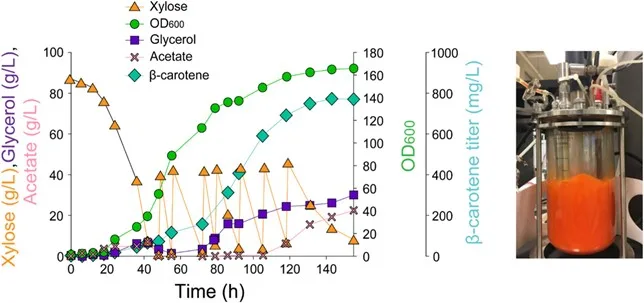High-Level β-Carotene Production from Xylose by Engineered Saccharomyces cerevisiae without Overexpression of a Truncated HMG1 (tHMG1)
Themes: Conversion
Keywords: Genome Engineering
Citation
Sun, L., Atkinson, C.A., Lee, Y.G., Jin, Y.S. July 17, 2020. Data from: “High-Level β-Carotene Production from Xylose by Engineered Saccharomyces cerevisiae without Overexpression of a Truncated HMG1 (tHMG1).” University of Illinois Urbana-Champaign. DOI: 10.13012/B2IDB-4573999_V1.
Overview

β‐Carotene is a natural pigment and health‐promoting metabolite, and has been widely used in the nutraceutical, feed, and cosmetic industries. Here, we engineered a GRAS yeast Saccharomyces cerevisiae to produce β‐carotene from xylose, the second most abundant and inedible sugar component of lignocellulose biomass. Specifically, a β‐carotene biosynthetic pathway containing crtYB, crtI, and crtE from Xanthophyllomyces dendrorhous was introduced into a xylose‐fermenting S. cerevisiae. The resulting strain produced β‐carotene from xylose at a titer threefold higher than from glucose. Interestingly, overexpression of tHMG1, which has been reported as a critical genetic perturbation to enhance metabolic fluxes in the mevalonate pathway and β‐carotene production in yeast when glucose is used, did not further improve the production of β‐carotene from xylose. Through fermentation profiling, metabolites analysis, and transcriptional studies, we found the advantages of using xylose as a carbon source, instead of glucose, for β‐carotene production to be a more respiratory feature of xylose consumption, a larger cytosolic acetyl‐CoA pool, and an upregulated expression level of rate‐limiting genes in the β‐carotene‐producing pathway, including ACS1 and HMG1. As a result, 772.8 mg/L of β‐carotene was obtained in a fed‐batch bioreactor culture with xylose feeding. Considering the inevitable large scale production of xylose when cellulosic biomass‐based bioeconomy is implemented, our results suggest xylose utilization is a promising strategy for overproduction of carotenoids and other isoprenoids in engineered S. cerevisiae.
Data
Illinois Data Bank includes:
- Transcriptional levels of related genes on glucose and xylose in engineered S. cerevisiae
- Batch fermentation profiles of SR8B on glucose and xylose conditions and β-carotene production
- β-carotene production by the engineered strains
- Ergosterol production on glucose and xylose
- Xylose fed-batch fermentation in a bioreactor